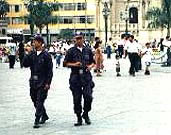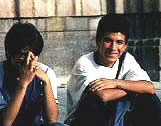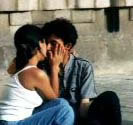(Updated January 2015)
A New Age and a New Scene
Attitudes towards gays in Peru have changed for the better over the past ten years.  Part of the force behind this social evolution are the worldwide emergence, publicity and activity of international pro-gay advocates led by high ranking people as the United Nations Secretary Ban Ki-moon as well as US President Obama and other heads of state in Europe.
Part of the force behind this social evolution are the worldwide emergence, publicity and activity of international pro-gay advocates led by high ranking people as the United Nations Secretary Ban Ki-moon as well as US President Obama and other heads of state in Europe.
Also influential are major sports figures coming out, as well as gay and lesbian federal judges, country ambassadors, high-ranking clergy, openly gay elected congress and parliament members, gay political leaders such as the mayors of Berlin and Paris and at least two Prime Ministers in Europe.
Closer to Peru, there are equality laws in 6 of the 12 sovereign countries in South America (most of the continent) which recognize some type of same-sex unions. Same-sex marriage is currently fully legal in Argentina, Brazil and Uruguay. An additional three countries have a some form of civil union or registered partnership, Chile, Colombia and Ecuador.
No civil society can ignore such influence as the 21st progresses and LGBT citizens are acknowledged and awarded equal rights. Now, in only one South American country is homosexuality illegal, Guyana in the northeast of the continent. However change is afoot there as well: in 2013 the Government there created a Parliamentary Commission to decide whether to scrap the Guyana’s sodomy laws.
As for Peru the most significant shift is manifested the now annual gay Pride Parade through the city streets–a Christopher Street type event with bright colors, loud music, happy faces and floats with male and female bikini dancers showing off lots of feathers, boas and skin. Last year the mayor of Lima walked with the celebrants in the parade in a show of solidarity for human rights. There is now an openly gay elected member of parliament, Carlos Bruce. In 2013 a very public billboard campaign in Lima was mounted to help combat homophobia by displaying famous Peruvians posing as if they were gay couples. In 2014, 3000 people marched in the center of the city in support of a proposed civil unions bill in Peru. Hate speech has been made illegal and the age of consent is the same for gays and straights. In 2015 congressman Bruce is again submitting a civil union bill.
Of course, these actions do not portend a society-wide turnaround from long-established homophobia. More accurately it is a modest shift away from the hiding and fear that most urban LGBT Peruvians have lived with for generations. My friend and activist Jose no longer hides in shadows fearing the scorn of his family or the authorities. He meets up with some of his LGBT friends at Haiti cafe and discos such as Lagendaros where happy lesbians and gay guys dance away the hours. He participates in LGBT advocacy. The website GayPeru.com is a trendy happening site with listings for discos, saunas, hotels, health clinic, cafes, esthetic spa, travel services, shopping suggestions–all in Lima.
A key player in this shift is the gay rights organization Movimiento Homosexual de Lima (The Homosexual Movement of Lima MHOL) that has been happening in Lima since 1982. It is the oldest lesbian gay organization operating in Latin America. “We advocate freedom, justice and equity to promote and ensure the full development to all Peru’s members without any form of exclusion, including those based on sexual orientation and gender identity of individuals,” says their website. Due to their advocacy Peru now has anti-discrimination laws in employment as well as military service and police work. The laws also protect age, race, religion, gender and sexual orientation.
 Despite such recent tolerance transvestites are often treated with unfair and rude treatment by the authorities. This quiet long-suffering community of daring LGBTs takes bold risks in order to subsist. They are shunned, shamed and scorned by most Peruvian as misfits. Little compassion comes from the Church toward these individuals especially the sex workers who ply their trade perhaps less out of courage than the need to survive.
Despite such recent tolerance transvestites are often treated with unfair and rude treatment by the authorities. This quiet long-suffering community of daring LGBTs takes bold risks in order to subsist. They are shunned, shamed and scorned by most Peruvian as misfits. Little compassion comes from the Church toward these individuals especially the sex workers who ply their trade perhaps less out of courage than the need to survive.
But they endure, partly out of their own willfulness but also, in no small part, due to the service they provide to this male-dominated culture that publicly proscribes– especially from the pulpit–sexual behavior outside of marriage. ‘Good’ girls do not offer themselves to eager young men fearing dishonoring their families and incurring judgment from the Church. Consequently, since human nature is hardly contained by repressive rules, lady-men become an integral part of the private lives of many straight and bi men looking for temporary relief.
Voice of a ‘Moderno’ Gay
The effects of the more protective laws, of course, did not suddenly open Peruvian culture to embrace sexual varieties by any means. A handful of activists hardly constitute a gay movement with much influence, but a clean sense of ‘pride’ urges them on as MOHL continues as a grass roots organization pushing for enforcement and acceptance of the anti-discrimination statute.
For those accustomed to oppression and harassment, the years since the law passed have seen an easing of police attitudes towards lesbigays, at least in Lima. Such were the thoughts of Jose Cruces (not his real name), a ‘typical’ gay guy whom we met on the Internet before we arrived in Lima. Bright-eyed, energetic, occupied with friends, family, work and some play, he visited us one evening and talked for a couple of hours about his life in Lima and Peru.
He is a bouncy young man in his twenties with dark short-cropped hair, cornsilk smooth skin and full lips that typify modern descendants of the Inca nation. His English was half-good and we supplied the other half as we conversed about growing up gay in Peru.
 He considers himself to be a ‘moderno’ gay man, more open about his sexuality, less fearful of the authorities (but not recklessly so), socially out and active with lesbian and gay friends. He said he is less ruled in the machismo-male role of being the dominant partner in bed. “For me being gay is how I feel with another man, not just sex and being on top”, he explained. “My friends also think the same, but we are young and the older ones do not understand. For them it was pretending to be straight. But I am a man and I can enjoy my gay identity too.”
He considers himself to be a ‘moderno’ gay man, more open about his sexuality, less fearful of the authorities (but not recklessly so), socially out and active with lesbian and gay friends. He said he is less ruled in the machismo-male role of being the dominant partner in bed. “For me being gay is how I feel with another man, not just sex and being on top”, he explained. “My friends also think the same, but we are young and the older ones do not understand. For them it was pretending to be straight. But I am a man and I can enjoy my gay identity too.”
Although the law is legally forgiving, Jose went on to note that most lesbigays still live in fear and shame, especially regarding one’s family. The ‘sin’ of being gay runs very deep here, but he was hopeful the new law would help gay people feel better about themselves and for straight people to be more open and more modern.
“Our Congress approved the new law and it acknowledges our sexual condition against discrimination; it’s good, because we have rights and we can protest when anybody discriminates against us…but it will take time because gay people are still afraid of their families”, he observed. Although he very much admired the success that MOHL has achieved, he felt that few would consider anything so bold as being publicly gay: “it’s hard for anybody to go and walk in a parade, like you do, telling everybody that you’re gay. It’s almost impossible…maybe next year.”
Changing Attitudes
Meanwhile, such fears have not stopped Jose and many younger lesbigays from forming networks of contacts, love and support in private in recent years.
Peru has been hobbled by nearly four hundred years of Catholic intolerance toward homosexuality. But laws and attitudes are eventually absorbed and shaped by newer myths, lifestyles and cultural changes that emerge from the vortex of everyday life. Love wills itself out, regardless of form or object or orientation.
 For straight Peruvians, the ‘Love Park’ that overlooks the Pacific Ocean from the cliffs of Lima is populated at sunset with entwined and handholding couples lounging in the fading amber light. Every bench and level wall space is usually occupied by these mostly young lovers whispering sweet nothings to each other.
For straight Peruvians, the ‘Love Park’ that overlooks the Pacific Ocean from the cliffs of Lima is populated at sunset with entwined and handholding couples lounging in the fading amber light. Every bench and level wall space is usually occupied by these mostly young lovers whispering sweet nothings to each other.
No less motivated are the countless lesbigays who create their own meeting places, although more discreetly. Jose seemed pleased to inform us of Lima’s new bounty of gay locations, some of them not far from our hotel in the upscale and touristy Miraflores district. “Oh yes, there are many.” he announced, “there is Tivoli bathhouse in San Isidro and the Gitano Disco just around the corner from here; if you want strippers there is Disco Perseo–they also lip sync too…”
He continued listing a dozen venues where lesbigays folks cruise, dance, drink, sunbathe or swap gossip over coffee in this ancient buzzing city of five million. Increasingly, he declared, bold gay couples a beginning to live together without excessive worry, yet still with some caution toward spying eyes or wagging tongues. The way, as with most Inca secrets, is smooth discerning judgment cloaked in silence.
I was about to find out just what modern Inca discernment really meant.
Blithe Indifference
The most intriguing comment to slice through most of the bilingual conversation with Jose was that some ‘Limeno’ men liked sex with other guys but did not identify themselves as gay.
In their minds they were normal guys exercising their male prerogative to act on their sexual urges by performing acceptable ‘active’ guy roles. Among man-to-man sexual intimates this is a clever–and dubious–use of denial wrapped in disguise and relabeled: screwing around with other guys but not by queers, gays or homos.
Rather, they are ‘hombres’ who are blithely confident they are straight because they only perform the macho-insertor role during rowdy romps with guys. Apparently, as long as you’re on top you’re not queer–simply because you say so.
 Jose did not think highly of these men. “I think they are ashamed but they are too old to change their thinking”, he said as we sat in the trendy sidewalk Haiti Cafe the next day.
Jose did not think highly of these men. “I think they are ashamed but they are too old to change their thinking”, he said as we sat in the trendy sidewalk Haiti Cafe the next day.
I was intrigued to hear about these men who behave the same way I do yet without accepting the label attached to same-sex orientation. It was certainly denial, but, as Jose described these men, it seemed a denial in the service of self-preservation and personal power. In a tightly proscribed Christian paradigm that forbade human nature from expressing its full truth, this denial and re-labeling seemed almost as clever as it was effective.
Sex vs Labels
What is real, the act or the meaning of the act? Much has been said about ‘machismo’ role in Latin America, so crowded with men who followed the church and state to the altar and produced little Peruvians.
As we sat in the popular cafe on the park in Miraflores watching the varieties of Limenos pass by, a friend of Jose’s happened by. Stylish, lean, dark eyes and shiny hair, Isidro was one of the ‘hombres’ Jose had been talking about–guys who like sex with men but who deny they are gay.
Isidro smiled, sat down and leaned back confidently in his wicker chair as if he had possessed it for years. Jose told him what we were talking about, softening his attitude a bit so as not to offend his friend. Isidro (‘Iso’) seemed interested but a little apprehensive. He squinted at me when I asked him if I could ask him some personal questions. As a long-time friend of Jose’s (he knew Jose was gay) he was willing to talk about his own private life.
 I appreciated this glimpse into a shaded world of discretion and secrecy. Despite a well-documented history of quirky sexual practices among the old Incas modern Peru offers risky territory for men or women who stray beyond the straight moral codes and roles.
I appreciated this glimpse into a shaded world of discretion and secrecy. Despite a well-documented history of quirky sexual practices among the old Incas modern Peru offers risky territory for men or women who stray beyond the straight moral codes and roles.
Over a tiny frothy cappuccino I commented about men who have sex with men. I asked him: “Can a man fuck other men with pleasure and not be homosexual?” Iso looked a little surprised. “Of course. You don’t know this?” he said with a laugh. Then pointing at Jose, “he does the same but he likes to say he is gay. But that is not the way for me.”
I replied, “you screw men and you are not gay?” With a backward wave of his hand he replied: “Of course not. I am a man and I do what men do. If my partner wants to be a woman with me, that’s up to him. It doesn’t matter what’s between his legs…”
I asked, “Do you have a regular guy you see? Someone special?”
“I see several guys, but I see one more.”
“Do you love him.”
“Si, but not all the way.” There was a vague uncertain bend in his voice as he replied. It seemed his feelings pressed against his words.
“Is he your ‘boyfriend’, you know, like a serious girl you might want to marry?”
He gave me a puzzled look: “What are you talking about? A man is only serious about a woman, not a man. We make children and the woman is happy, my family is happy.”
“You are married?”, I said, trying not to sound surprised.
I looked at Jose who shrugged: “you didn’t ask.”
“Yes. Of course. It’s what a man does here”, said Iso.
“But you prefer to be with men?”
“For sex, yes, why not. It is more pleasurable. Men give me better sex than my wife.”
“But you are not gay?”
“No. I am a man”
“So you are bisexual?”
“No, because I do not really like sex with women. But I can do it and makes my family happy. And I love my children. They also make me feel sure I am a man…”
I restrained an impulse to challenge him on his self-deception. But, I thought, this protective seal, this not-gay label was imperative to his self-image and I had no permission or need to question it. He lived within that frame of identity, privately, and no one seemed harmed (deceived but not harmed?) his take on reality worked the way he needed.
 Nevertheless, my thirty-year experience of gay-pride warfare across the globe, including violence and death, felt somewhat offended at this man’s simplistic denial of the truth about homosexual human nature. I felt proud of and a part of the greater struggle for that truth and dignity. Iso was a man who simply brushed off this great crusade to validate our (his!) natural sexual reality. The struggle, for him, simply didn’t exist. He sought no validity for his gayness; he simply liked sex with men. Stonewall had no existence for him.
Nevertheless, my thirty-year experience of gay-pride warfare across the globe, including violence and death, felt somewhat offended at this man’s simplistic denial of the truth about homosexual human nature. I felt proud of and a part of the greater struggle for that truth and dignity. Iso was a man who simply brushed off this great crusade to validate our (his!) natural sexual reality. The struggle, for him, simply didn’t exist. He sought no validity for his gayness; he simply liked sex with men. Stonewall had no existence for him.
“I’m a man–give me a man, but I’m no queer!” The deception did not sit well with me. But I recalled Jose’s comment that Iso was probably “too old to change.”
Revision of a Revision
Fortunately, after Iso left, Jose helped to sooth my wrinkled thoughts. He shrugged his shoulders, not unaccustomed to such men. He suggested we call them ‘not-gay queers’, laughing at both my puzzled brow and Isidro’s denial.
I felt beamed back into ordinary reality by Jose’s easy reduction of Iso’s doppelganger reality. “Lots of these guys are married but don’t want to be at home, so they make outside arrangements. Usually they rent a hotel room, and they avoid fems and nellies. They are very afraid of association–always afraid of their families or straight friends.”
I had to appreciate the careful choreography and creative logistics that served Iso in his double life and his gay-not-queer orientation. I reluctantly admired his blithe indifference to reality as defined by others, especially his Catholic-Macho-hetero world models, yet while satisfying his deep homoerotic desires.
 So, in Lima I saw an intricate humanscape with different faces, different roles and divergent attitudes. The game played by a closeted married man of forty wove a very different pattern than my young friend Jose. This young ‘moderno’ was openly gay to himself and his circle of friends, comfortable with top or bottom or three-ways, resistant to parental pressure to raise a family, dressed casually, well educated and well employed.
So, in Lima I saw an intricate humanscape with different faces, different roles and divergent attitudes. The game played by a closeted married man of forty wove a very different pattern than my young friend Jose. This young ‘moderno’ was openly gay to himself and his circle of friends, comfortable with top or bottom or three-ways, resistant to parental pressure to raise a family, dressed casually, well educated and well employed.
He was also quite savvy with the Internet having built a web site last year (GayPeru.com) that greets a visitor with the requisite flesh for attracting others of the gender. He was, also, for me a moderno of courage and integrity.
The ancient and modern city by the sea was a surprise study that reminded me, again, of the wondrous complexity and diverse expressions of being gay around the world.
Comments from a traveler (March 2006):
I stayed in a very nice gay B and B in the Miraflores area. It just opened in January and is owned by an American ex-marine. It’s called Mansion San Antonio. The same guy owns a small gay bar in another part of the city.The night I went there with him they were having a karaoke contest. It was fun with a mixed gay and lesbian crowd. Also went to a good size disco called Downtown that was very busy both nights I went. (In June 2007 Downtown is not listed in http://lima.queercity.info/discos.htm.)
I suppose Lima like any big city is a bit more open to alternative lifestyles. And these days especially the younger gay crowd isn’t as inhibited about being themselves.
I did however talk to more than one young guy who told me that they were either hiding being gay from their family or were out but that they had been rejected by one or both parents. Of course the Catholic church is a big influence here which doesn’t help.
There’s a small bar in Arequipa and a weekend-only disco.
In Cusco there’s a mixed restaurant called Fallen Angel and a couple of gay friendly bars.
Also see:
Gay Peru News & Reports 2000 to present
Gay Peru Photo Galleries
















